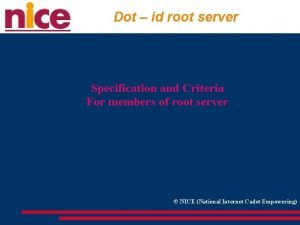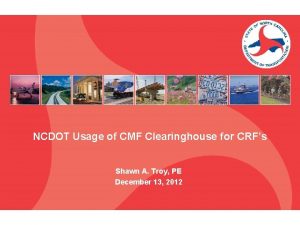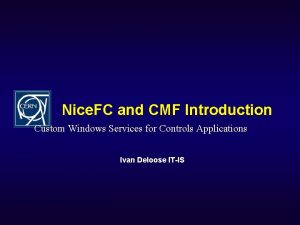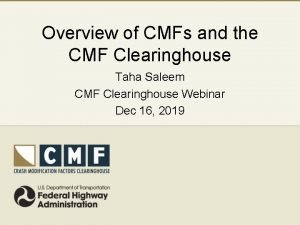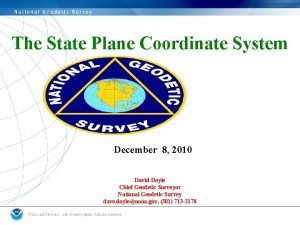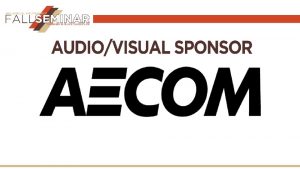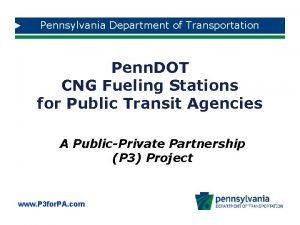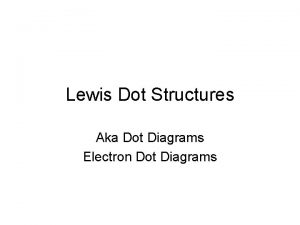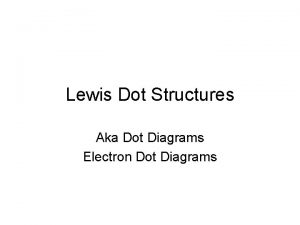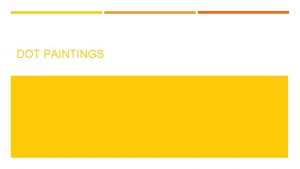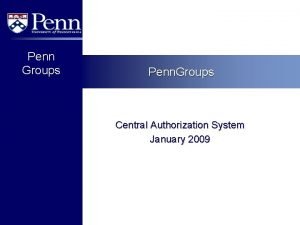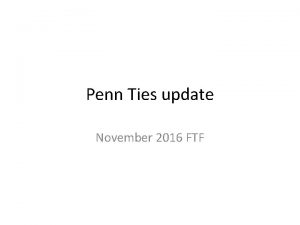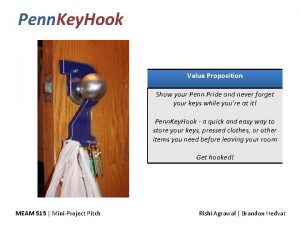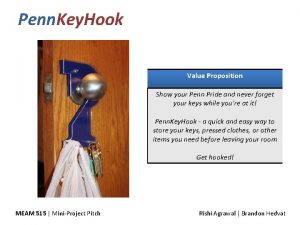The Pennsylvania CMF Guide Penn DOT HSM Analysis






















- Slides: 22

The Pennsylvania CMF Guide & Penn. DOT HSM Analysis Tool The Pros and Cons

Pennsylvania CMF Guide & Penn. DOT HSM Analysis Tool • • Who developed the PA CMF Guide What is it Why it was developed Data and how to use it Advantages (Pros) Disincentives (Cons) Penn. DOT Analysis Tool

History • CMF Guide developed by University • Completed August 2014 • CMF Practitioners Guide developed by consultant firm • Completed April 2016

Pennsylvania CMF Guide • The Pennsylvania CMF Guide provides list of high-quality Crash Modification Factors appropriate for use in Pennsylvania • CMF data obtained mainly from FHWA CMF Clearinghouse website, www. cmfclearinghouse. com • The Practitioner's Guide establishes a consistent approach to the application of Crash Modification Factors (CMFs) within the context of the Highway Safety Manual (HSM) and the Penn. DOT HSM analysis tools.

Data and Use (Basics) Assessing CMF Quality • Use rating system proposed by CMF Clearinghouse • Each CMF assigned score from 1 (worst) to 5 (best) stars based on (Same as CMF Clearinghouse): – – – Study design Sample size Standard error Potential bias Data source • Only 3+ star CMF included in guide and suitable for use in PA

Data and Use CMFs Categorized Into 19 Tables – Access Management – Advanced Technology and ITS – Alignment – Bicyclists – Delineation – Highway Lighting – Interchange Design – Intersection Geometry – Intersection Traffic Control – On-Street Parking – Pedestrians – Railroad Grade Crossings – Roadside Features – Roadway Features – Shoulder Treatments – Signs – Speed Management – Transit – Work Zones *Does contain sections for CMFs equations and another section for Lower Quality CMFs

CMF Tables • Each table provides information on the conditions for which the CMF applies, which include: – – – Roadway/area type Crash severity Level of traffic (AADT) Other implementation notes • CMFs should only be directly applied to the same conditions • CMFs might serve as a guide for other conditions

Using the CMF Tables • Highlighted: recommended values • Bolded: values estimated using PA data

Advantages (Pros) • Uniform Statewide list of part D CMFs • Can be printed and used as a book • Used to develop consistent results in Penn. DOT’s HSM analysis tool • Shows higher quality CMFs (3 stars or higher) • Shows CMFs that used Pennsylvania data

Disincentives (Cons) • Outdated once it was published – Clearinghouse is always being updated • Not web based and as easy to access as • Not as easy to use as CMF Clearinghouse • Does not include the CMF ID numbers – Harder to reference more information about the CMF(s) selected • Expensive to develop • Includes some CMFs that aren’t used in PA – HAWKS, pelican to puffin crossings • No Part D CMFs were created by Penn State for the CMF Guide

Penn. DOT HSM Analysis Tool • Penn. DOT has HSM Analysis Tools A & B available at: https: //www. penndot. gov/Travel. In. PA/Safety/Pages/Safety-Infrastructure-Improvement. Programs. aspx Tool B contains the part D CMFs for alternatives analysis PA CMF Guide Part D CMF tools for lane & shoulder widths and adjustments to intersection skews (Cross-sectional)

Small to Moderate Scale Example For a small to moderate scale site Safety Assessment use Penn. DOT’s HSM Analysis Tools A & B or other spreadsheet tool options. Rural Collector in D-11, Beaver County

Use Penn. DOT HSM Analysis Tools A & B Existing Conditions: • Facility type: Rural Collector (rural 2 lane roadway) • District 11 -0 Beaver County • Length: 2 miles AADT: 4, 500 • Total Paved width: 22 feet • Lane width: 10 feet • Shoulder width & type: 1 foot / paved • Warning signs: not present Constraints: • ROW issues only allows for 26 feet of paved roadway width • Cost to obtain additional 4 feet of ROW is $350, 000 • Need to justify design exception for narrow shoulders Minimum AAHSTO Green Book Design Criteria: Rural Collector- (Penn. DOT DM community collector) • Lane width: 11 feet • Shoulder width & type: 4 feet / paved • Warning signs: not required

Apply Data to SPF Do not change the Blue data if you are using “PA SPFs”. Simply put, “Ignore the Blue entry fields”.

Crash Frequency Reports (Part C Base model)

Evaluate Safety Improvement Options -HSM part D Analysis)) Project Options: 1. 26 ft wide: 11 ft ln/2 ft shldr 2. 26 ft wide: 12 ft ln/1 ft shldr 3. 30 ft wide: 11 ft ln/4 ft shldr (Design standard) Time to use Tool B • Can Evaluate 3 options q 3 - CMFs per Alternative option • Has several known CMFs • Can add up to 3 user defined CMFs • Benefit Cost Analysis (BCA) • Use lane & shoulder width supplement tool Upload your “Tool A” file (part C analysis)

Enter Part D Analysis Data 1. Data Pulled from “Tool A” file 3. Customize User Countermeasures here (see next slides) 2. Select Countermeasures here

Shoulder & Lane Width CMF for Part D Analysis • <1. 0: Crash reduction • =1. 0: No change • >1. 0: Increases crashes Optimal lane & shoulder width with 26 feet of total pavement width

CMF List in the Tool

Benefit Cost Analysis Add necessary costs and service life for a BCA • Enter one at a time for each Option (Alternative) • Life cycles for different countermeasures can be different.

Summary of Project options Justifies DE

Questions
 192 dot 168 dot 1 dot 1
192 dot 168 dot 1 dot 1 Cmfclearinghouse
Cmfclearinghouse Cmf design award
Cmf design award Cmf cern
Cmf cern Cmf cern
Cmf cern Cmf clearing house
Cmf clearing house Emerson cmf200
Emerson cmf200 Liquorrea
Liquorrea Hpd 113 uitm
Hpd 113 uitm Utimaco hsm simulator
Utimaco hsm simulator Hsm traffic management
Hsm traffic management Hsm stream
Hsm stream Hsm design
Hsm design Hsm lisboa
Hsm lisboa 1-5 solving inequalities answers
1-5 solving inequalities answers Dot net vs php
Dot net vs php Www middleschoolscience com 2008
Www middleschoolscience com 2008 Pa state plane coordinate system
Pa state plane coordinate system Piedmont region pa
Piedmont region pa Rachel carson was born in 1907 in springsdale pennsylvania
Rachel carson was born in 1907 in springsdale pennsylvania Pennsylvania
Pennsylvania Xoom energy pennsylvania
Xoom energy pennsylvania New hire reporting program
New hire reporting program
